Winter Weekend Waterfowl Watching Provides Critical Data
Opinion Advocates for ideas and draws conclusions based on the author/producer’s interpretation of facts and data.

By Brian Kluepfel
This Saturday birders from around New York will converge on rivers, lakes, ponds and shorelines of the Empire State, from Lake Erie to the Long Island Sound, immersing themselves in the counting of ducks, loons, geese, swans and other aquatic avians.
The January Waterfowl Count (JWC) is part of a seven-decade tradition begun in 1955 by the New York State Ornithological Association. Except for a respite from 1968 to 1972, counting has been done annually each January, with results written up later in the same year in “The Kingbird,” the Ornithological Association’s official publication. The period spans the week leading up to and including Martin Luther King Jr. Day, with one “target day,” this year being Jan. 13.
In Westchester County, Saw Mill River Audubon will head up one group beginning at the Annsville Circle in Peekskill heading south along the Hudson, and another contingent heading north from Tarrytown’s Losee Park, in the shadow of the Mario M. Cuomo Bridge. The two groups, covering more than 20 sites, will converge in Croton Point Park, mull over the morning’s data and then head for local reservoirs in the afternoon.
In many years, more than a quarter-million birds are counted statewide, and the information is useful to the state Department of Environmental Conservation (DEC) in analyzing avian population trends. Of New York’s 10 divisions, Westchester is part of Region 9, also comprising Orange, Dutchess, Putnam, Ulster, Sullivan and Rockland counties.
Charlie Roberto of Croton-on-Hudson, who will lead the Annsville Circle group, points out the various advantages of the effort.
“The count helps the government set bag limits for duck hunters by assessing the data collected,” Roberto said. “It’s a way to study the impact of avian flu on geese and duck populations. (It) has documented a decline in many local wintering species.”
Reasons for the decline may include warming climates, disease or lack of food, he said.
The JWC requires many hands, eyes and hours. In 2020, for example, 337 volunteers took part (many professionals from the U.S. Fish and Wildlife Service, the New York City Department of Environmental Protection and DEC also aid the effort), logging 872 hours and tallying more than 380,000 waterfowl.
“As our climate changes, surveys like these become critical data points in understanding how waterfowl are adapting to the changing winters in our state,” said Putnam Highlands Audubon President Sean Camillieri, regional compiler for the Hudson Valley.
For the statistically-minded birder, the Ornithological Association’s website provides a wealth of Excel spreadsheets and PDFs with data spanning the decades.
On New Year’s Day, as our Amtrak train sped along the border of Lake Champlain, I marveled at the rafts of ducks bobbing on the waves and taking off in massive clusters. Dozens? Hundreds? I wondered who could count them all; now I know someone will certainly give it a shot this week.
For those interested in participating in the JWC in Westchester, you may contact Saw Mill River Audubon at 914-666-6503 or at www.sawmillriveraudubon.org.
For points further north, The Ralph Waterman Bird Club covers Dutchess County. For general information on the Waterfowl Count and to reach regional compilers, check the New York State Ornithological Association webpage at www.nybirds.org.
Brian Kluepfel is a member of Saw Mill River Audubon and a correspondent for the Lonely Planet travel series, Birdwatching magazine and many other publications. He lives and birds in Ossining.

Examiner Media – Keeping you informed with professionally-reported local news, features, and sports coverage.
